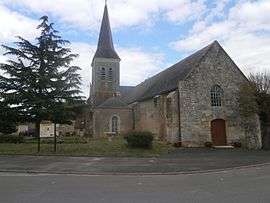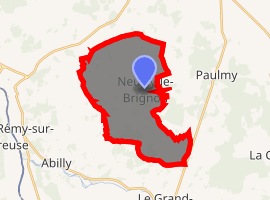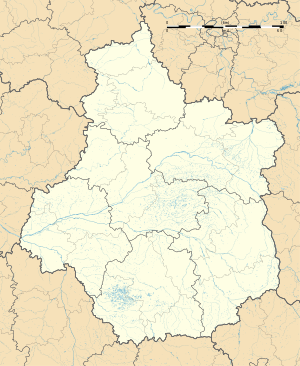Neuilly-le-Brignon
Neuilly-le-Brignon is a commune in the Indre-et-Loire department in central France.
Neuilly-le-Brignon | |
|---|---|
 Church of Saint Saturnin. | |
Location of Neuilly-le-Brignon 
| |
 Neuilly-le-Brignon  Neuilly-le-Brignon | |
| Coordinates: 46°58′32″N 0°47′24″E | |
| Country | France |
| Region | Centre-Val de Loire |
| Department | Indre-et-Loire |
| Arrondissement | Loches |
| Canton | Descartes |
| Intercommunality | CC Loches Sud Touraine |
| Government | |
| • Mayor (2014–2020) | Dominique Cointre |
| Area 1 | 22 km2 (8 sq mi) |
| Population (2017-01-01)[1] | 300 |
| • Density | 14/km2 (35/sq mi) |
| Time zone | UTC+01:00 (CET) |
| • Summer (DST) | UTC+02:00 (CEST) |
| INSEE/Postal code | 37168 /37160 |
| Elevation | 62–124 m (203–407 ft) |
| 1 French Land Register data, which excludes lakes, ponds, glaciers > 1 km2 (0.386 sq mi or 247 acres) and river estuaries. | |
It is a small village near Descartes, Le Grand-Pressigny, and Abilly.
History
The village of Neuilly-le-Brignon is mentioned for the first time by Gregory of Tours in the sixth century under the name of Noviliacus vicus and Nobiliacensis pagus. Later versions of the name can be found in references to Parochia de Nuilleis (1195), Nuillé (1234) and Nuilleius (18th century), but from the 15th to the 19th centuries it was most often called Neuillé or Neuilly le Noble, despite receiving its current name in 1793 at the height of the French Revolution.[2]
The church of Saint Saturnin was founded circa 550 by Saint Bauld, the bishop of Tours. The presence of walls of small stonework show that some of the building dates to at least the 11th century. The doorway dates from the 12th century with its typical four orders decorated with flowers, helices, nail heads and a torus decorated with a zig-zag pattern.[2]
Population
| Year | Pop. | ±% |
|---|---|---|
| 1793 | 702 | — |
| 1800 | 640 | −8.8% |
| 1806 | 713 | +11.4% |
| 1821 | 631 | −11.5% |
| 1831 | 760 | +20.4% |
| 1836 | 771 | +1.4% |
| 1841 | 602 | −21.9% |
| 1846 | 776 | +28.9% |
| 1851 | 746 | −3.9% |
| 1856 | 767 | +2.8% |
| 1861 | 753 | −1.8% |
| 1866 | 765 | +1.6% |
| 1872 | 702 | −8.2% |
| 1876 | 679 | −3.3% |
| 1881 | 689 | +1.5% |
| 1886 | 708 | +2.8% |
| 1891 | 690 | −2.5% |
| 1896 | 657 | −4.8% |
| 1901 | 628 | −4.4% |
| 1906 | 651 | +3.7% |
| 1911 | 652 | +0.2% |
| 1921 | 591 | −9.4% |
| 1926 | 566 | −4.2% |
| 1931 | 554 | −2.1% |
| 1936 | 570 | +2.9% |
| 1946 | 563 | −1.2% |
| 1954 | 555 | −1.4% |
| 1962 | 535 | −3.6% |
| 1968 | 476 | −11.0% |
| 1975 | 381 | −20.0% |
| 1982 | 325 | −14.7% |
| 1990 | 315 | −3.1% |
| 1999 | 308 | −2.2% |
| 2006 | 315 | +2.3% |
| 2009 | 311 | −1.3% |
References
- "Populations légales 2017". INSEE. Retrieved 6 January 2020.
- Commune de Neuilly-le-Brignon. "Histoire de la commune - Site officiel de la Mairie de Neuilly-le-Brignon (Indre-et-Loire, 37)". www.neuillylebrignon.fr. Retrieved 2017-11-10.
| Wikimedia Commons has media related to Neuilly-le-Brignon. |